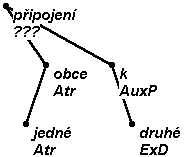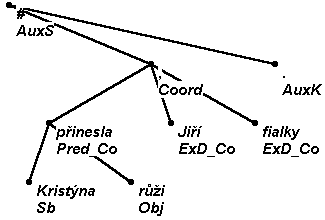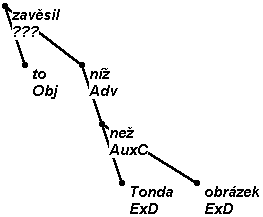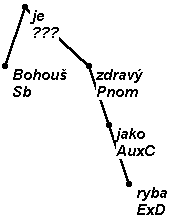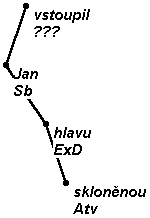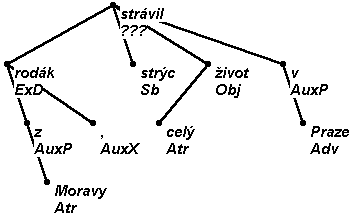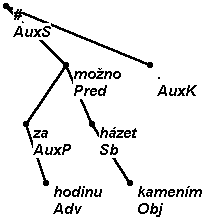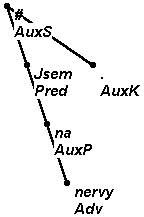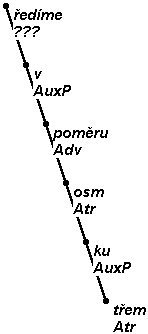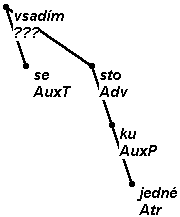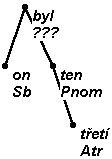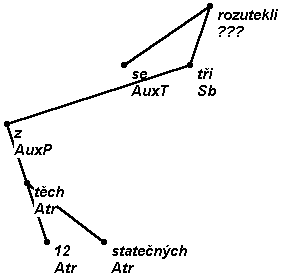In Specification of ellipsis and the afun ExD a specification of ellipsis is presented, followed by a list of its types, with an emphasis on the so-called actual (textual) ellipsis, represented by afun ExD.
The next section, Ellipses treated by means of afun ExD, is devoted to different cases of actual ellipses; the list is, of course, just a random selection of frequently occurring phenomena such as: deletions of predicates in one-member sentences (Ellipsis of predicate in one-member non-verbal sentences), deletion of predicate when repeated (exdpropa), deletion of predicate in clauses introduced by conjuctions as jako (like) and než (than), deletion of predicate in proverbs and sayings (Ellipsis of predicate in sayings and proverbs), deletion of the predicate být (to be) in verbal nominal predicate (Ellipsis of a verb in verbo-nominal predicates), deletion of the verb být (to be) as a component part of compound verb forms (Ellipsis of components of complex verbal forms) and deletion of a transgressive in complement constructions (Ellipses of a transgressive in constructions with complement).
The cases of so-called lexicalized ellipses, which are represented without the use of afun ExD, are described in Sect Ellipsis solved without afun ExD. This list is more definite and such types of deletions that are not listed there are represented by the afun ExD. The list contains the following items: deletion of the copula with some verbonominal predicates (Ellipsis of copula with some verbo-nominal predicates), deletion of a modified adjective with verbal predicates (Ellipsis of a predicate adjective), deletion of an attributive adjective standing between a noun and an adverb (Ellipsis of an adjective between a noun and an adverb), deletion of subject in the sentence (Ellipsis of subject), deletion of the governing clause (Ellipsis of the governing clause), deletion of noun with prepositions (Deletion of a noun after a preposition).
Ellipsis (deletion) is a deletion of an expression that is expected in the given syntactic structure. Ellipsis generally is conditioned by the topic-focus articulation. It is a typical means of spoken language; in written texts it occurs mainly in certain types of texts (addresses, questionnaires, forms etc.). The deletion is not determined by its syntactic function but rather by the fact whether the expression concerned is a part of the topic of the sentence or its focus; as a rule, the focus of the sentence cannot be deleted.
In our annotation scheme, the occurrence of deletion is marked by the the afun ExD, which is assigned to all nodes that would be suspended on the node that is missing in the sentence, and these nodes are suspended in the position in whch the missing node would have been suspended.
An exception to this rule are prepositions and subordinate conjunctions which get AuxP or AuxC, and the afun ExD "falls down" to the node that depends on them (and that constitutes a sentence member). A similar situation obtains with constructions with coordination and apposition, when ExD is shifted below, to the individual members of coordination or apposition, which are then marked as ExD_Co or ExD_Ap; the governing node of coordination or apposition keeps its afun Coord or Apos.
However, punctuation and other technical nodes can obtain ExD, in case their "proper" governing node is missing (see the examples in A syntactially non-incorporated sentence part or sentential form; ellipsis; an independent sentence part; vocative; interjection Exd_Pa).
Traditionally, ellipses are classified according to different criteria as follows:
With a contextual ellipsis, some syntactic members in the topic of the sentence are deleted in dependence on the context of the utterance. For instance, after the question Kam odjel váš bratr? (Where has your brother left for?) it is possible to use just the focus do Prahy (to Prague) as the answer. With a situational ellipsis, the members are deleted in dependence on the concrete situation: e.g. when meeting somebody, we can just say na procházku? (for a walk?) or when ordering a glass of beer one can just say jedno (one).
The most important for the purpose of our annotation judgements is the third type of classification quoted above. Actual ellipsis is captured by the afun ExD, while with a lexicalized ellipsis this afun is not used, since we do not feel it as a deletion at all. For the reasons of consistency, the sentence members syntactically dependent on the deleted word (which technically is suspended at the very position in which the deleted word would be suspended) are assigned either that function the word would have if nothing were deleted (jít go in ex. (1)), or the function of the deleted word (hodiny o'clock in ex. (2)). An actual ellipsis occurs only in the given context, it is not connected with any fixed expression. The sentence members depending on the deleted word are assigned ExD and are suspended in the place where the deleted member would be placed (the second occurrence of obce villages in ex. (3).
Compare One-member sentences without a verb ExD, ExD_Co
Notation: words with ExD are emphasized.
Afun ExD is used if these conjunctions are not followed by a sentence with a predicate or a sentence member that gets afun Adv according to the rule qutoed in the part advjakne in Adverbials (and borderline cases) and esp. also in Phrases of comparison with conjunctions jako (as), než (than). (The sentence member gets Adv if it relates in some close way to the node immediately above the conjunction - it is of the same type and it itself might fulfil the role of the member it modifies (lépe než dobře better than well, více než pět more than five, široký jako vysoký wide as high)
Notation: words with ExD are emphasized.
If a copula is deleted with a verbo-nominal predicate, the subject (Sb) and the nominal part (Pnom) as well as all other modifications dependening on the copula get the afun ExD. There are exceptions to this rule mentioned in the part Ellipsis of copula with some verbo-nominal predicates.
Notation: words with ExD are emphasized.
If the auxiliary verb být (to be) - which in a full predicate is assigned afun AuxV, see predsloz - occurs without its meaningful verb on which it would have been suspended, it is assigned afun ExD (e.g. if the sentence Budu (I will) should mean Budu jíst (I will eat)).
Notation: words with ExD are bold-faced.
The problem of these constructions is described in the part Complement with elided transgressive Atv, AtvV. The missing transgressive would be the complement.
Notation: words with ExD are emphasized.
There exist expressions that commonly occur with a copula as a nominal part of the predicate and as such can be deleted. If the copula is present, then these constructions are analyzed according to the rules for verbo-nominal predicate quoted in part the structure of verbal-nominal predicate (the copula is assigned afun Pred, the dependent nominal part gets the afun Pnom).
If the copula is absent, the function of Pred is taken over by the nominal part and this part then has the function of a full predicate (all modifications depend on it).
Expressions that belong to this group are given by the following list: třeba, nutno (necessary), možno, záhodno (possible) (or, as the case may be, their negative counterparts).
The deletion in this case results in problematic constructions. The dependent member is assigned afun Adv. In the sentence below the word nemocný (sick) is missing, the modification na nervy (on nerves) is thus suspended under jsem (I-am).
The adverb may sometimes take over the function of an attribute. This happens when an adjective is deleted from a full construction (mostly derived from a passive: platby požadované předem payments required in advance). See also the part Non-agreeing attribute expressed by an adverb.
Sentences with a deleted subject part are not considered as incomplete sentences, we do not speak about ellipsis. See also the part Modifying predicate.
When a governing clause that need not be repeated is deleted, we get a sentence in the form of a dependent clause. Its predicate is assigned Pred rather than the relevant syntactic function that it would obtain if it were included in a full complex sentence, or afun ExD.
Numerals (a numerical expression of a number), even if not accompanied by the units they count, are regarded as sentence parts with the function that the node appurtenant to the unit would acquire.
An exception to this rule (i.e. the numerical expression gets ExD) is the type of coordination illustrated in the last example, where the given treatment is required by the overall structure of the sentence.
Deletion often occurs with expressions of proportion (esp. numerical proportion), when the word poměr (proportion) is omitted. If this word is present, it gets its conventional afun:
If the word poměr (proportion) is omitted, its syntactic function is taken over by the first member of the proportion:
Warning
If the relation is not expressed in words, it is represented as a coordination (see the part Coordination with a colon):
These pronouns stand for a sentence member, so that no ellipsis is concerned. However, if accompanied by the word which this pronoun refers to, this word itself fulfils the given function and the pronoun functions as its Atr.
In some cases only the preposition is left in the sentence in place of a prepositional group. If this is a collocation (phraseme), the preposition can take over the function of the member that it would introduce. E.g. in the sentence jsem pro (I am for) the preposition pro gets afun Adv (this function would be assigned to the deleted word, e.g. návrh proposal, přijetí acceptance, schválení approval, usnesení decision, ...). If a collocation is not the case, and the deletion is just occasional (e.g. náhle zmizel za ... suddenly he disappeared behind ...), the preposition gets its usual afun AuxP and nothing is suspended on it.


